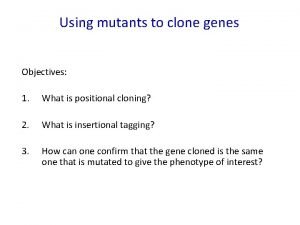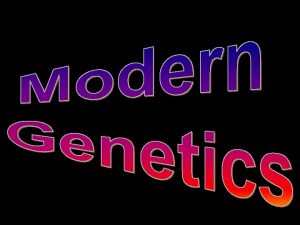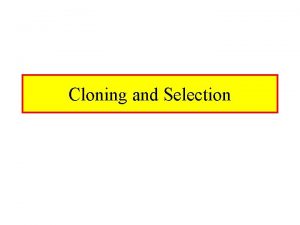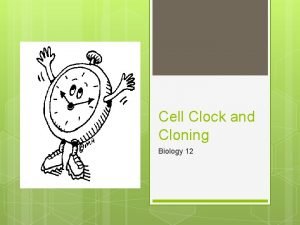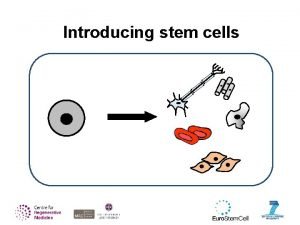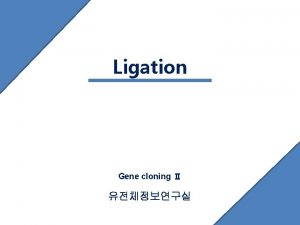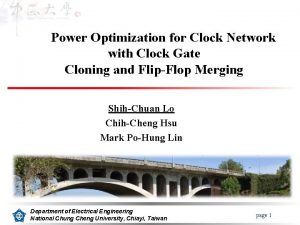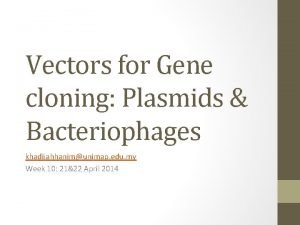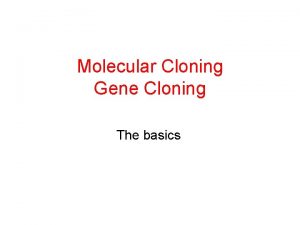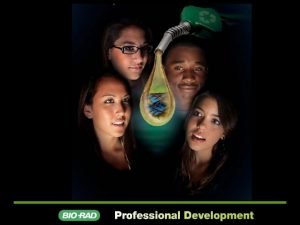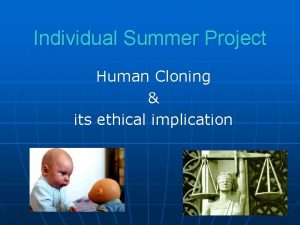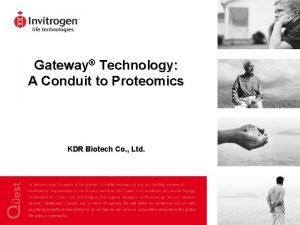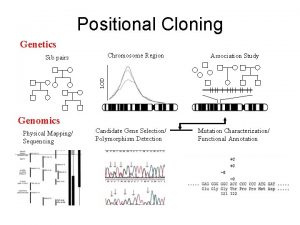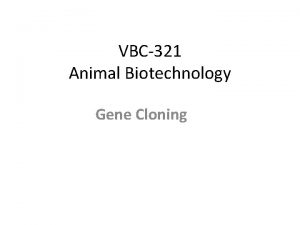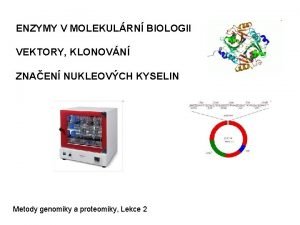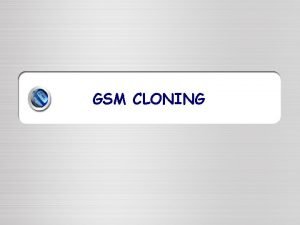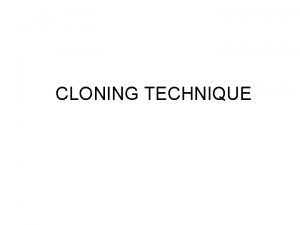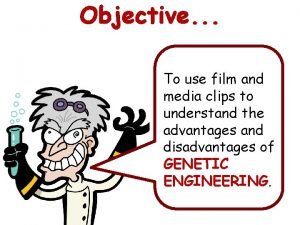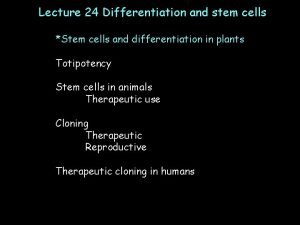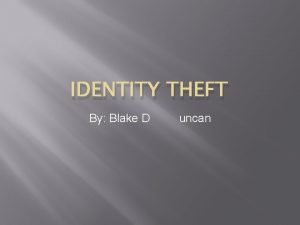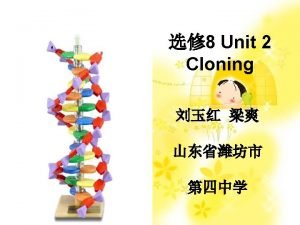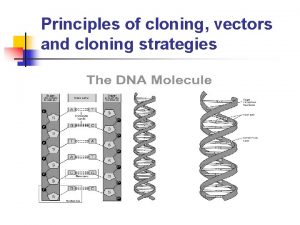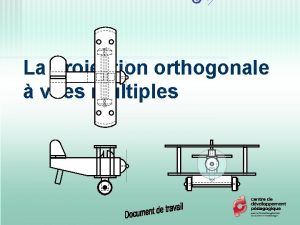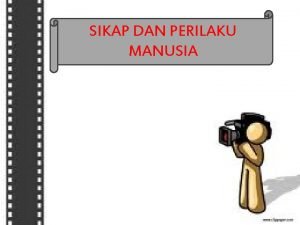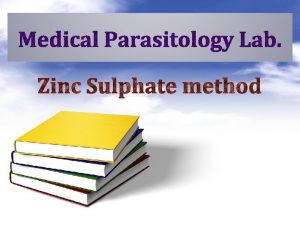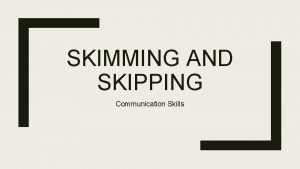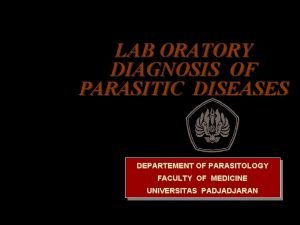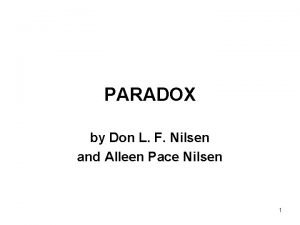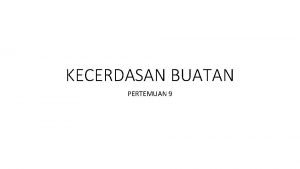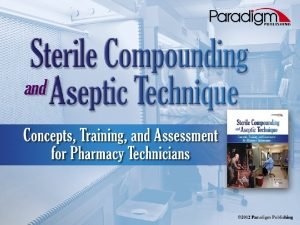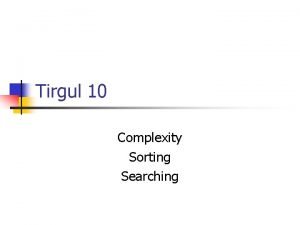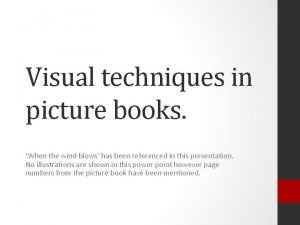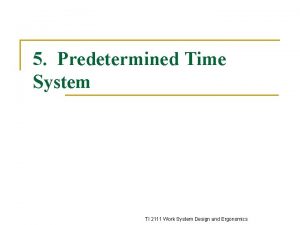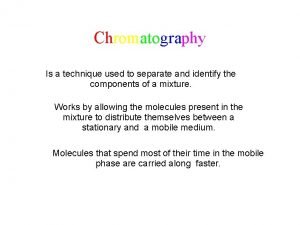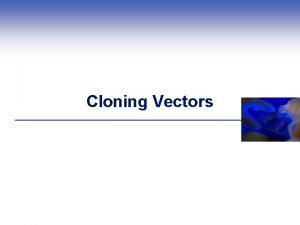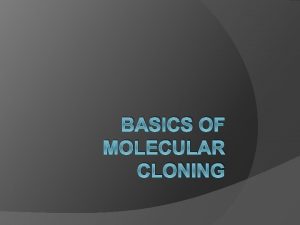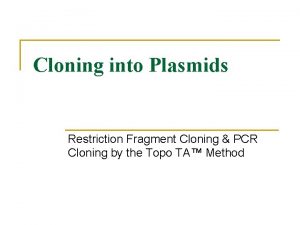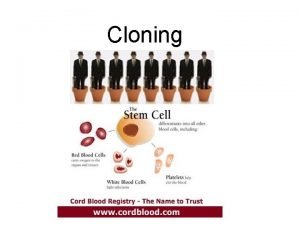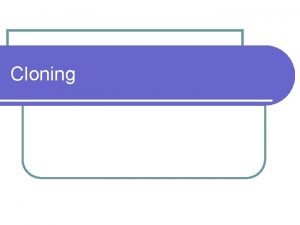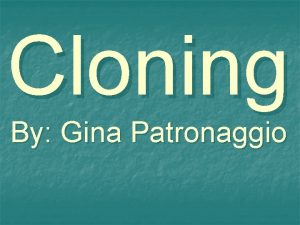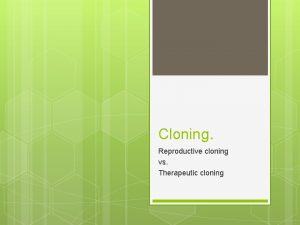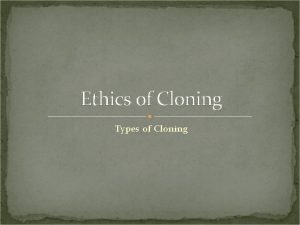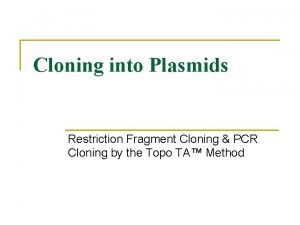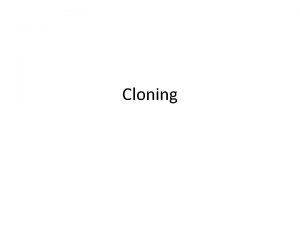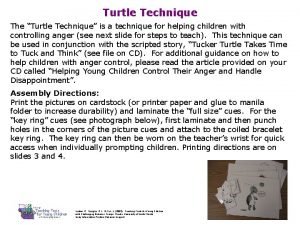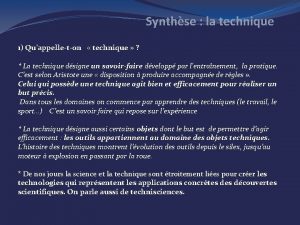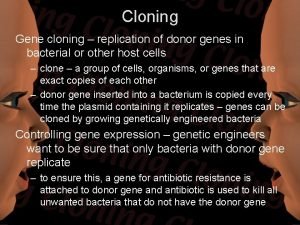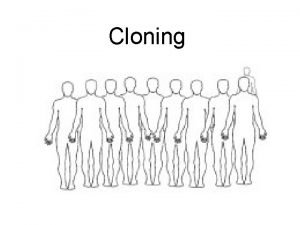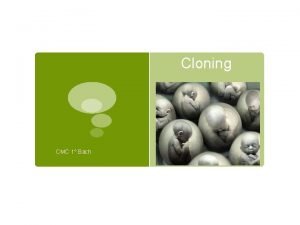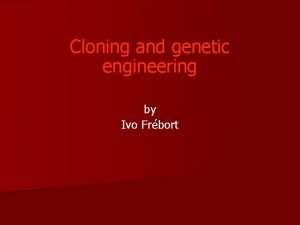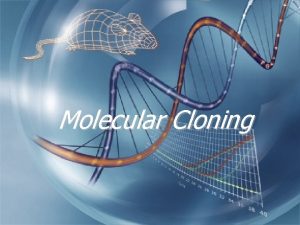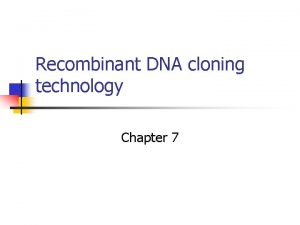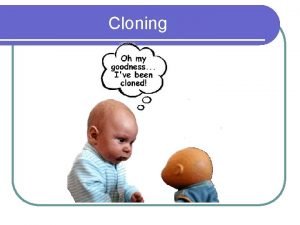CLONING TECHNIQUE What is cloning Cloning is a










































- Slides: 42

CLONING TECHNIQUE

What is cloning ? Cloning is a process that create an exact genetic replica of another cell, tissue or organism. Copied material that has the same genetic makeup as the original is called CLONE.

History of cloning • • • Tadpole: (1952) Carp: (1963) – China - Tong Dizhon - World's first cloned fish Mice: (1986) - First successfully cloned mammal - Chaylakhyan, Veprencev, Sviridova, and Nikitin Sheep: (1996) - From early embryonic cells by Steen Willadsen. From differentiated embryonic cells by Megan and Morag (1995) From somatic cell - Dolly the sheep (1997). Rhesus Monkey: Tetra (2000) - From embryo splitting Gaur: (2001) - First endangered species. Cattle: Alpha and Beta (Males, 2001) and (2005) Brazil Cat: Copy. Cat "CC" (f. Late 2001) Little Nicky (2004, ) - First cat cloned Mule: Idaho Gem (2003) - First horse-family clone Horse: Prometea, (2003) - First horse clone. Water Buffalo: Samrupa (2009) - First cloned water buffalo. At India’s Karnal National Diary Research Institute but died five days later due to lung infection. Camel: (2009)- Injaz - First cloned camel.

Carp was the first cloned fish, in China by an embryologist Tong Dizhou in 1963. Michigan State University researchers developed a new, more efficient way of cloning zebra fish, Zebra fish is an excellent model for understanding normal development and birth defects

Dolly - First mammal cloned from an adult cell by Roslin Institute in Scotland She lived from 1996 to 2003 Her stuffed remains are placed at Edinburgh's Royal Museum

Types of cloning • Molecular cloning • Cellular cloning • Organism cloning Create copies of genes or segments of DNA Create copies of cells Create copies of whole animals

Molecular cloning • Process of making multiple copies of a defined DNA sequence. • Used to amplify DNA fragments containing whole genes • It can also be used to amplify any DNA sequence such as promoters, non-coding sequences and randomly fragmented DNA. • It is used in a wide array of applications ranging from genetic fingerprinting to large scale protein production.


Recombinant DNA technology or DNA cloning • A piece of DNA from one organism is transferred to a self replicating genetic element such as a bacterial plasmid. • Plasmid is then transferred to a bacterium, where multiple copies of the same gene are generated.

Origin of replication • To amplify any DNA sequence in a living organism, that sequence must be linked to an origin of replication • Origin of replication is a sequence of DNA capable of directing the propagation of itself and any linked sequence.

Cloning vector • A variety of specialized cloning vectors exist. • Cloning vector is a small piece of DNA into which a foreign DNA fragments can be inserted. • These vectors allow protein expression, tagging, single stranded RNA and DNA production.

Cloning of DNA fragment 1. 2. 3. 4. Fragmentation - breaking apart a strand of DNA Ligation - gluing together pieces of DNA in a desired sequence Transfection - inserting the newly formed pieces of DNA into cells Screening/selection - selecting out the cells that were successfully transfected with the new DNA

Fragmentation: DNA of interest needs to be isolated Ligation Amplified fragment is inserted into a vector (piece of DNA). Vector is linearised using restriction enzymes Vector is incubated with the fragment under appropriate conditions with an enzyme, DNA ligase.

Transfection • Vector with the insert of interest is transfected into cells. • Chemical sensitivation of cells, electroporation, optical injection and biolistics. Culturing • Transfected cells are cultured. Identification of clones • Cloning vectors include selectable antibiotic resistance markers, which allow only cells in which the vector has been transfected to grow. • Cloning vectors also contain colour selection markers, which provide blue/white screening on X-gal medium. • Further identification by means of PCR, restriction fragment analysis and/or DNA sequencing. Electroporation is a technique that to temporarily punch holes in cell membranes and ferry drugs or genes into them

Colour changing gene, lac. Z was added This enables the bacteria to turn the colourless substance X -gal/IPTG blue This gene split apart when the clone DNA is incorporated into the vector It is possible to tell that the bacteria had been transfected (incorporated into the cell) and also the bacteria was transfected with the vector containing insert DNA or just the vector alone (remembering that if the vector has properly incorporated the clone DNA, it will have lost its ability to change X-gal blue)

Cellular cloning • Cloning a cell means to derive a population of cells from a single cell. • In this, a single-cell suspension of cells are exposed to a mutagenic agent or drug and this is done to drive selection • It is then plated at high dilution to create isolated colonies • Each arise from a single and potentially clonally distinct cell. • At an early growth stage when colonies consist of only a few of cells, sterile polystrene rings (cloning rings), dipped in grease are placed over an individual colony and a small amount of trypsin is added. • Cloned cells are collected from inside the ring and transferred to a new vessel for further growth.

Cloning cell-line colonies using cloning rings


History • First recorded cloning began in 1901 by Hans Spemann, who split one newt cell into two, which eventually grew into two newts. • Spemann won the Nobel Prize in Medicine in 1935. • In 1964, an entire carrot was grown from one carrot cell without the need for transference by F. C. Stewart. • Cell cloning was refined in 1990's because a suitable growing medium was developed.

Benefits • There is no need for an entire creature to be subjected to experiments • So medical experiments can be done faster, cheaper and more reliably. • Cellular cloning also eliminates a lot of ethical issues such as the issue of using animals or human fetuses in experiments. • Cellular cloning also has a higher success rate than DNA transference cloning.

Organism cloning • Creation of a new multicellular organism, genetically identical to another. • This form of cloning is an asexual method of reproduction, where fertilization or inter-gamete contact does not take place. Different types • Embryo cloning • Reproductive cloning • Therapeutic cloning

Embryo cloning • “Artificial twinning" or “Embryo splitting”. • Mimics the natural process of creating identical twins. • In nature, twins occur just after fertilization of an egg cell by a sperm cell. • When the fertilized egg, called a zygote, tries to divide into a two-celled embryo, the two cells separate. • Each cell continues dividing on its own and ultimately develop into a separate individual within the mother. • Since, two cells come from the same zygote, the resulting individuals are genetically identical.

Artificial embryo twinning • This occurs in a Petri dish instead of mother's body. • Involves manual separation of individual cells from an early embryo • Then allow each cell to divide and develop on its own with the same DNA as the original. • It is performed at the 6 - to 8 -cell stage, where it can be used as an expansion of In-vitro fertilization (IVF) to increase the number of available embryos. • Resulting embryos are then placed into a surrogate mother, where they are carried to term and delivered. • Since all the embryos came from the same zygote, they give rise to monozygotic (genetically identical) twins. • It has been successfully carried out on many animals. • Very limited experimentation has been done on human embryos.


Human embryo cloning • • • Starts with a standard in vitro fertilization • • Zygote divides first into two cells, then four, then eight. . . • They are then coated with an artificial zona pellucida and allowed to divide and develop. • Best results obtained by interrupting zygote at the two cell stage. Sperm and an egg cell are mixed together on a glass dish. After conception, the zygote (fertilized egg) is allowed to develop into a blastula. Chemical is added to the dish to remove the "zona pellucida" covering. This material provides nutrients to the cells to promote cell division. With this covering removal, blastula is divided into individual cells which are deposited on individual dishes.

Reproductive cloning • Is to create an animal that has the same DNA as another animal. • Dolly the sheep - first animal created by reproductive cloning. • DNA from an ovum is removed and replaced with DNA from a somatic cell removed from an adult animal. • The fertilized ovum, called a pre-embryo, is implanted in a uterus and allowed to develop into a new animal. • Clones of adult animals are created by a process called Somatic Cell Nuclear Transfer (SCNT). • Roslin Technique and Honolulu Technique. • Resulting offspring will be genetically identical to the donor and not the surrogate, unless the donated nucleus is taken from a somatic cell of the surrogate.


Cloning techniques Somatic Cell Nuclear Transfer • Refers to the transfer of the nucleus from a somatic cell to an egg cell. • A somatic cell is any cell in the body other than the two types of reproductive cells (germ cells), sperm and egg. • Example of somatic cells - blood cell, heart cell, skin cell • Every somatic cell has two complete sets of chromosomes, whereas germ cells only have one complete set. • Nucleus contains all the information in the form of DNA that cells need to form an organism.

• First egg from a female donor is taken and its nucleus is removed to create an enucleated egg. • A somatic cell, which contains DNA, is taken from person who is being cloned. • Then enucleated egg is fused together. • This creates an embryo, which begins to divide normally. • Then it is implanted into the uterus of the surrogate mother through in vitro fertilization. • Clone will be an exact genetic replica of the adult that donated the somatic cell nucleus to the egg.

Difference between fertilization and SCNT • First difference lies in those two sets are originated. • In fertilization, sperm and egg both contain one set of chromosomes. • When the sperm and egg join, the resulting zygote ends up with two sets - one from the father (sperm) and one from the mother (egg). • In SCNT, the egg cell's single set of chromosomes is removed. • It is replaced by the nucleus from a somatic cell, which already contains two complete sets of chromosomes. • The resulting embryo contain both sets of chromosomes come from the somatic cell.

The Roslin Technique • Roslin Technique is a variation of SCNT • Roslin Institute researchers used this to create Dolly. • In this process, somatic cells with nuclei intact are allowed to grow and divide • They are then deprived of nutrients to induce the cells into a suspended or dormant stage. • An egg cell that has had its nucleus removed is then placed in close proximity to a somatic cell and both cells are shocked with an electrical pulse. • Cells fuse and egg is allowed to develop into an embryo. • Then, the embryo is then implanted into a surrogate.

The Honolulu Technique • This technique was developed by Dr. Teruhiko Wakayama at the University of Hawaii. • In this method, the nucleus from a somatic cell is removed and injected into an egg that has had its nucleus removed. • The egg is bathed in a chemical solution and cultured. • The developing embryo is then implanted into a surrogate and allowed to develop.

Problems in reproductive cloning • Clones are not strictly identical since the somatic cells may contain mutations in their nuclear DNA. • Additionally, the mitochondra in the cytoplasm also contains DNA • During SCNT process, this DNA is wholly from the donor egg, thus the mitochondrial genome is not the same as that of the nucleus donor cell from which it was produced. • This may have important implications for crossspecies nuclear transfer in which nuclearmitochondrial incompatibilities may lead to death.

Therapeutic cloning • Initial stages are identical to reproductive cloning. • The stem cells are removed from the pre-embryo with the intent of producing tissue or a whole organ for transplant back into the person who supplied the DNA. • The pre-embryo dies in the process. • The goal of therapeutic cloning is to produce a healthy copy of a sick person's tissue or organ for transplant • SCNT process used to create embryos for therapeutic purposes. • This process is also called "research cloning". • The goal is to harvest stem cells that can be used to study human development and to potentially treat disease.

• Resultant embryo is allowed to grow for perhaps 14 days. • Stem cells would then be extracted and encouraged to grow into a piece of human tissue or a complete human organ for transplant. • End result would not be a human being; it would be a replacement organ, or piece of nerve tissue, or quantity of skin. • First successful therapeutic cloning was accomplished in 2001 by Advanced Cell Technology, a biotech company in Worcester, MA. • Goal of therapeutic cloning is to create an organ to heal people. • Orrin Hatch (R-UT), a pro-life senator has suggested the term "somatic cell nuclear transfer" to replace therapeutic cloning.

• All the information needed to create a new human being is contained in each cell of an existing human being. • DNA testing on a human often starts by scraping some cells from the inside of a person's mouth. • Living cells can be scraped off of a person's skin that contains the DNA of the person • Thus they contains all of the information required to produce a duplicate or cloned person. • Each cell is, in fact, a form of human life for the simple reason that it contains human DNA. • A woman's ovum also contains her DNA.

• Take a woman's ovum, and remove its DNA. This converts it to a form of human life. • Remove the DNA from a cell taken from a human, and insert it into the ovum. • Give an electrical shock to the resulting ovum to start up its embryo making operation. In a small percentage of cases, a pre-embryo will be formed. • The pre-embryo is allowed to develop and produce many stem cells. • The procedure is identical to that used in reproductive cloning. However, the pre-embryo is not implanted in a woman's womb. • Stem cells are removed from the pre-embryo this results in its death. • Stem cells would be encouraged to grow into whatever tissue or organ is needed to treat the patient. • Stem cells are a unique form of human cell that can theoretically develop into many organs or body parts the body. • Tissue or organ would be transplanted into the patient.

• Theoretically, these stem cells can be used to develop into replacement organs (heart, liver, pancreas, skin, etc) • There were four main hurdles. 1. Stem cells have to be "successfully isolated and grown in the laboratory. " 2. They have to be encouraged to "turn into specific cell types. " 3. They have to be proven usable in treating patients with diseases, injuries, or disorders. 4. The transplanted tissue must develop normally and must not represent significant "risks to the patient. "

Therapeutic cloning • Cloned embryo develops only to the blastocyst stage. At this stage, a cluster of cells — the Inner cell mass (ICM) — is evident at one side of the embryo. ICM is the source of pluripotent (totipotent) embryonic stem (ES) cells. These cells can then be induced to differentiate into specific cell types, These can be used to treat diseases that result from the loss and/or malfunction of particular cells. Reproductive cloning • In reproductive cloning, after going through the Morula stage and reaching the blastocyst stage, the cloned embryo is implanted into the uterus and allowed to develop further. • The aim is for the clone to develop to term and be born in the same way as non cloned offspring.

Pluripotent, embryonic stem cells originate as inner mass cells within a blastocyst. The stem cells can become any tissue in the body, excluding a placenta. Only the morula's cells are totipotent, able to become all tissues and a placenta.

Advantages of Cloning 1. Solution to infertility 2. Provide organs for transplantation 3. Provide treatments for variety diseases 4. Genetic modification / engineering 5. The healthiness of infants 6. Better understanding of genetic diseases 7. Help improve lives 8. Protects Endangered Species 9. Improves food supply

Disadvantages of Cloning 1. The Element of Uncertainty Before the cloning of Dolly was achieved, many embryos (277 Nos) were destroyed. 2. Inheriting diseases Cloning creates a copy of the original. A human clone would therefore inherit the genetic traits of its predecessor, which includes genetic abnormalities and diseases. 3. The Potential for Abuse If human cloning became a reality what checks and balances would be put in place to prevent abuse? Would scientists go overboard with the technology? If a couple has a clone that they are not happy with, what would they do next? Clones could be grown in a farm-like fashion simply for harvesting organs or stem cells. The potential for devaluing human life cannot be ignored.
 Inverse pcr
Inverse pcr Process of cloning
Process of cloning Suspension cloning
Suspension cloning Advantages and disadvantages of cloning
Advantages and disadvantages of cloning Cloning in nature
Cloning in nature Reproductive cloning
Reproductive cloning Gene cloning
Gene cloning Clock gate cloning
Clock gate cloning M13 phage vector
M13 phage vector What is cloning
What is cloning Steps of gene cloning
Steps of gene cloning Cloning and sequencing explorer series
Cloning and sequencing explorer series Clonaid
Clonaid Kdr gateway
Kdr gateway Helpx
Helpx Positional cloning
Positional cloning Plasmid
Plasmid Topo ta cloning
Topo ta cloning Logan stancato
Logan stancato Cloning vector
Cloning vector Genetic engineering steps
Genetic engineering steps Gsm cloning
Gsm cloning History of cloning
History of cloning Advantages and disadvantages of cloning
Advantages and disadvantages of cloning Therpeutic cloning
Therpeutic cloning Identity cloning and concealment
Identity cloning and concealment Advantages of cloning
Advantages of cloning क्लोनिंग वेक्टर
क्लोनिंग वेक्टर Projection orthogonale dessin technique
Projection orthogonale dessin technique Contoh dari metode the low-ball technique
Contoh dari metode the low-ball technique Taenia solium
Taenia solium What is skiming
What is skiming Charcot leyden crystals parasites
Charcot leyden crystals parasites What is grandfather paradox
What is grandfather paradox Plain folks
Plain folks Transient line source system
Transient line source system Teknik dekomposisi
Teknik dekomposisi Aseptic garbing technique
Aseptic garbing technique A sorting technique is called stable if: *
A sorting technique is called stable if: * List of visual techniques
List of visual techniques Maynard operation sequence technique
Maynard operation sequence technique Affinity chromatography animation
Affinity chromatography animation Scratching method of striking an arc
Scratching method of striking an arc
